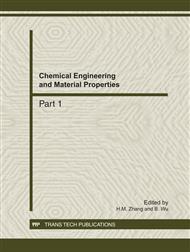p.138
p.143
p.147
p.151
p.156
p.161
p.165
p.170
p.175
Research on the Interfacial Tension between Anion Gemini Surfactant Solution and Crude Oil
Abstract:
Both transient-state and steady-state interfacial tension (IFT) between anion Gemini surfactants solution and crude oil were measured. The effects of various parameters such as anion Gemini surfactant molecular structure, concentration, category of crude oil and salinity of water medium on the interfacial tension between crude oil and water were investigated in detail. The results reveal that when the length of the carbon chain or the carbon number of spacer is constants, the increase of either carbon number of interval groups or length of carbon chain is favorable to decrease the interfacial tension. AN12-4-12 has the lowest interfacial tension. As the concentration of anion Gemini surfactant increasing, the interfacial tension between crude oil and water decreases. Anion Gemini surfactants which have a larger carbon number of interval group and longer hydrophobic carbon chain have a better interfacial activity. AN12-4-12 has the best interfacial activity. When the concentration of AN10-4-10, AN12-4-12 reaches up to 2000 mg•L-1, it can lower the steady-state oil-water IFT to 10-3 mN•m-1. Different kinds of crude oil have different effects of decreasing IFT and different interfacial activity for the same anion Gemini surfactant. The Critical Micelle Concentration (352mg•L-1, 487mg•L-1) of AN8-4-8 and AN12-4-12 between thin oil and water interface is obviously lower than those (1000mg•L-1, 3000mg•L-1) between mixed heavy oil and water interface. But molecular structure still has a larger influence on interfacial tension than category of crude oil. The IFT between AN12-4-12 solutions and mixed heavy oil lower an order of magnitude than that between AN8-4-8 solutions and mixed heavy oil. As the solution salinity increased, the interfacial tension between anion Gemini surfactant solution and thin oil decrease rapidly. The longer the hydrophobic carbon chain is, the more obvious the effect of salinity is. The salinity is not less than 1.2×105 mg•L-1, AN12-4-12 can decrease the oil-water interfacial tension to 2.2×10-3 mN•m-1, while AN8-4-8 only makes that reduce to 9.7×10-3 mN•m-1.
Info:
Periodical:
Pages:
156-160
Citation:
Online since:
December 2011
Authors:
Price:
Сopyright:
© 2012 Trans Tech Publications Ltd. All Rights Reserved
Share:
Citation:


